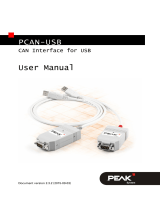
PCAN-PCI – User Manual
10
Low power devices (e.g. bus converters) can be supplied directly
with 5 volts over pin 1 and/or pin 9 of the CAN connector. Pin 1
and/or pin 9 are not in use at the delivery state. For more
information see the next section 3.2.
Tip: You can connect a CAN bus with a different transmission
standard via a bus converter. PEAK-System offers different bus
converter modules (e.g. PCAN-TJA1054 for a Low-speed CAN
bus according to ISO 11898-3).
3.2 Voltage Supply of External Devices
External devices with low power consumption (e.g. bus converters)
can be directly supplied via the CAN connector (independently for
each connector on the dual channel version). With a solder bridge
per CAN channel on the PCAN-PCI board, a 5-Volt supply can
optionally be routed to pin 1 and/or pin 9 of the D-Sub connector.
The opto-decoupled versions of the card contain an interconnected
DC/DC converter. Therefore, the current output is limited to about
50 mA.
Do the following to activate the voltage supply:
Risk of short circuit! Solder with great care to avoid unwanted
short circuits on the card.
Attention! Electrostatic discharge (ESD) can damage or destroy
components on the card. Take precautions to avoid ESD.
Set the solder bridge(s) on the card according to the desired
settings.
Figure 3 shows the solder field positions on the card. The table
be
low contains the possible settings.






















